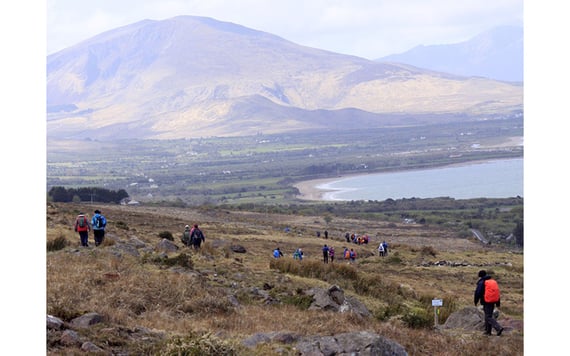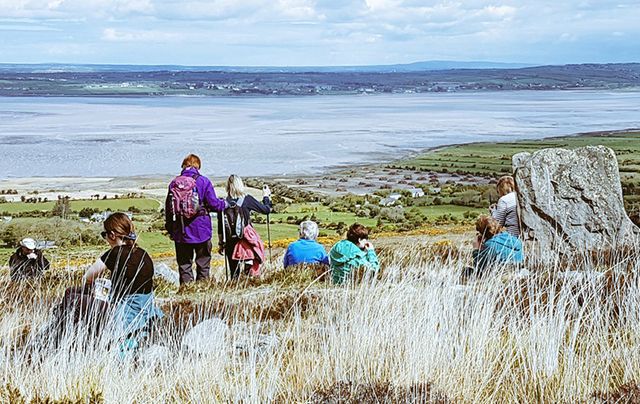The Camino de Santiago, the pilgrims walk which ends in Spain, tends to come up regularly when you bring up the topic of bucket-lists with travelers, as well as visiting Ireland, of course. Now these two need not be mutually exclusive as the Kerry Camino has officially been recognized by the powers that be in Spain.
The Camino Society Ireland announced "The Cathedral of Santiago has agreed to grant a Compostela to pilgrims who complete the 75km [46.6 miles] Camino Ingles route from A Coruña to Santiago, as long as they have already completed a certified 25km [15.5 miles] pilgrimage in their country of origin."
Walkers in County Kerry can have their passports officially stamped in “The Kingdom” and then on arrival in Spain only need walk 46.6 miles to Compostela de Santiago. Ordinarily they would need to walk at least 62.1 miles. Now Kerry Camino walkers can travel to the cities of A Coruña and Ferrol and continue their journey to Santiago, along the English Way (Camino Inglés).

The English Way (Via CaminoWays.com)
This novice walker heard the good news of the “Celtic Camino’s” launch at the Kerry Camino Festival over the May bank holiday weekend (first weekend in May). The Kerry Camino is a 57km (35 mile) walk from Tralee to Dingle, spread over three days. For anyone who loves the Irish countryside and walking it is a little slice of heaven and in my opinion, there’s no better way to take in the towns and countryside along the route.
This section of the Dingle Way, the Kerry Camino is managed and maintained by a spectacular group of locals, many of them small business owners, who saw what a wonderful resource they had on their doorstep and worked hard to bring it to this successful point. The Kerry Camino brings travelers along the foothills of the Slieve Mish mountains overlooking Tralee Bay; across the Finglas River after Camp village and the nearby ruin of Killelton Church dating from the 9th or 10th Century. The trail then brings the walkers on to Inch beach, through Annascaul (home of Kerry explorer Tom Crean) and past Minard Castle, with the holy well of St John the Baptist beside it; on along through Lispole village and into Dingle.

Stunning views along the Kerry Camino (Via: CaminoWays.com)
Read more: Is this the most beautiful walk in Ireland?
It was along this route during the years between 512AD and 530AD that Saint Brendan, the patron saint of Kerry and the American Navy, went forth to spread the word of God. This was a journey of fasting, prayer and contemplation. It’s said that he traveled from the Island of Iona for seven years, to the shore of the New World, believed to have been America.

Statue of Saint Brendan in Fenit, County Kerry.
While this agreement with the Camino de Santiago (The Way of St. James) and the Kerry Camino is relatively new, there is evidence that this part of Ireland was always a pilgrim’s route linking Ireland to Spain – going back over 1,000 years.
The shell, a symbol worn by Camino walkers around the world, is one associated with St. James.
Today the cover of the Kerry Camino log book features a drawing of an artifact discovered during an archaeological dig, in 1992, of a medieval tomb at Ardfert Cathedral, just a few miles north of Tralee. The artifact was a pewter scallop shell with a bronze-gilded statue of Saint James attached and mounted on a brooch. It is believed that this was a pilgrim’s badge.

The Kerry Camino logo, a pilgrim's badge of St. James and his shell.
The shell, always associated with Saint James, and when it's found in a grave it suggests that the person has been on a pilgrimage to the apostle’s burial place in Spain.
The tradition of the pilgrimage to Santiago dates back over 1,000 years. Legend has it that Saint James found his way to the Iberian Peninsula and preached there and Compostela de Santiago became his final resting place.

Compostela de Santiago, Spain.
Although Pope Leo XII accepted the authenticity of the relics at Santiago in 1884, the Vatican remains uncommitted but supports the general benefits of the pilgrimage to the site. Today more than 200,000 pilgrims travel to the UNESCO city from all over the world. The oldest know Camino route starts from Oviedo (Asturias) and is known as the Original Way, but the longest route starts in Paris, France. Traditionally the Camino starts at home and now it can start in County Kerry.
Buen Camino!
For more visit CaminoWays.com.




Comments